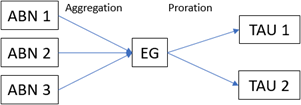Household statistics produced by the Australian Bureau of Statistics (ABS) play a critical role in informing the nation’s most important decisions. To produce high quality and timely statistics, the ABS must effectively engage with households from across the country that have been selected to participate in a household survey. The purpose of this project was to take a human-centred design approach to improve the ABS’ engagement strategy with households selected for ABS surveys.
The project comprised three phases – Discovery, Prototype, and Test. As part of the Discovery phase, the project team conducted a ‘sludge audit’ (Sunstein, 2021), involving mapping out the current ABS respondent journey for a household survey and identifying key pain points in the process based on feedback from previous survey respondents.
The project team also conducted a literature review of ABS and wider academic research to understand the barriers different demographic groups typically have when interacting with government services. This review also identified several best practice engagement strategies to overcome these barriers. For example, complex language can pose a significant barrier to engagement for groups with lower levels of English literacy, such as Culturally and Linguistically Diverse (CALD) groups or those with disabilities that affect literacy. Therefore, using simple language with a clear call to action would benefit multiple demographic groups.
From the Discovery phase, the following principles for designing an effective engagement strategy emerged:
- give clear and transparent call to action
- use simple language
- clearly define the survey scope and purpose
- include clear compulsion messaging
- offer multiple modes of survey completion (for example, online and phone)
- reduce the amount of postal mail where possible.
In the Prototype phase, these principles were used to develop a new suite of engagement materials. These prototypes were iteratively improved across two rounds of cognitive interviews with members of the public to optimise level of engagement and understanding. Receiving feedback on the design from members of the public was critical to the success of the project.
The new materials were trialled as part of the Test phase, using a randomised controlled trial (RCT) within the Monthly Population Survey (MPS). The RCT was done to ensure that the new strategy did not inadvertently have a negative impact on response rates. The combined findings from the cognitive interviews and the RCT demonstrated that despite the reduction in the number of materials sent to respondents, the new suite of materials was engaging for respondents and had no significant impact on response rates. Achieving the same response rates by sending fewer materials means that we can reduce costs for the ABS and reduce cognitive burden on respondents without compromising data quality.
As a result of the project findings, the updated materials now form the basis for the standard suite of approach letters used for ABS household surveys. So far, we have implemented this new suite into the MPS and the 2023-24 Survey of Income and Housing.
For more information, please contact Yvette Kezilas.
Reference:
Sunstein, C. (2021). Sludge: Bureaucratic Burdens and Why We Should Eliminate Them. MIT Press LTD. USA.
